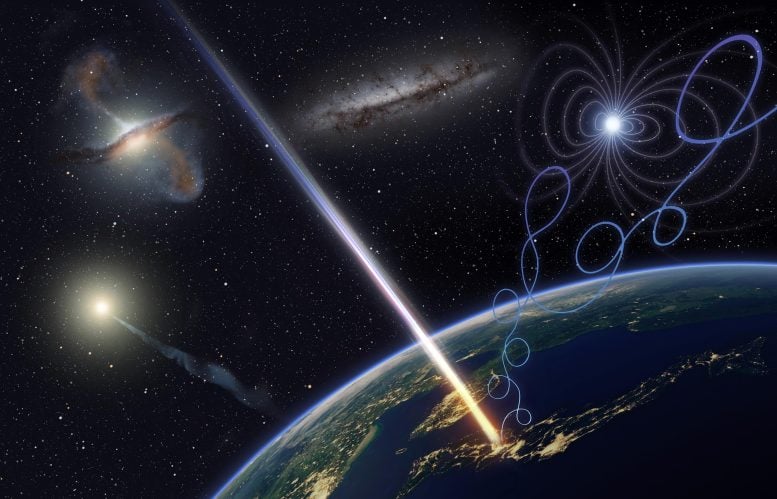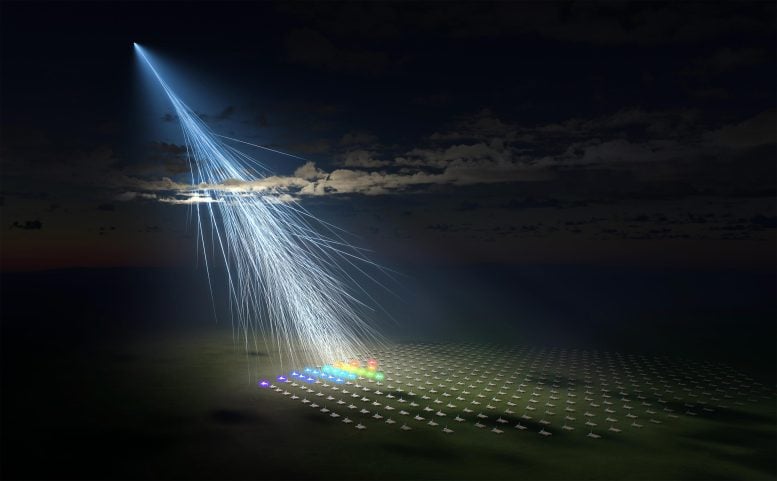Artist’s illustration of extremely high-energy cosmic rays called “Amaterasu particles” observed by the Telescope Array Experiment’s surface detector array. Image source: Osaka Metropolitan University/L-INSIGHT, Kyoto University/Ryuunosuke Takeshige
The Telescope Array Experiment’s groundbreaking detection of extremely high-energy cosmic rays raises questions about their origins as it points to cosmic voids, challenging current theories of cosmic ray origins and high-energy physics.
A special alien particle discovered
Researchers involved in a telescope array experiment announced the detection of unusually high-energy cosmic rays. This particle originates outside our galaxy and possesses an astonishing energy level of over 240 exaelectronvolts (EeV). Despite this remarkable discovery, its exact origin remains elusive, as its direction of arrival does not point to any known astronomical entity.
The mystery of ultra-high energy cosmic rays
Cosmic rays are subatomic charged particles coming from space, of which ultra-high-energy cosmic rays (UHECR) are a rare and unusually powerful type. These UHECRs possess energies in excess of 1 EeV, approximately one million times greater than what man-made particle accelerators can achieve. They are thought to originate from the most energetic phenomena in the universe, such as those involving black holes, gamma-ray bursts and active galactic nuclei. However, their exact physics and acceleration mechanisms are still not fully understood. The rarity of these high-energy cosmic rays—estimated at less than one particle per square kilometer per century—makes their detection a rare event, requiring instruments with huge collection areas.

Artist’s illustration of ultra-high-energy cosmic ray astronomy, which aims to illustrate extremely high-energy phenomena compared to weaker cosmic rays affected by electromagnetic fields.Image source: Osaka Metropolitan University/Kyoto University/Ryuunosuke Takeshige
Unique discovery of telescope array
The Telescope Array (TA) experiment in Utah, a large surface detector array with an effective detection area of 700 square kilometers, successfully detected UHECR with a breakthrough energy of approximately 244 EeV on May 27, 2021.
Given the extremely high energy of the particle, the researchers note that it should be deflected only relatively slightly by the foreground magnetic field and, therefore, its direction of arrival should be more closely related to its source. However, the results show that its arrival direction does not reveal an obvious source galaxy, nor any other known celestial body considered a potential source of ultra-high-energy particle radiation.
Instead, its arrival direction points to a void in the large-scale structure of the universe—a region that is rarely inhabited by galaxies. Scientists believe this may indicate a much larger magnetic deflection than predicted by galactic magnetic field models, possibly an unknown source in the local extragalactic neighborhood, or an incomplete understanding of the associated high-energy particle physics.
More information about this discovery:
Reference: “Extremely high-energy cosmic rays observed by the Surface Detector Array,” Telescope Array Collaboration*†, RU Abbasi, MG Allen, R. Arimura, JW Belz, DR Bergman, SA Blake, BK Shin, IJ Buckland, BG Cheon , T. Fujii, K. Fujisue, K. Fujita, M. Fukushima, GD Furlich, ZR Gerber, N. Globus, K. Hibino, R. Higuchi, K. Honda, D. Ikeda, H. Ito, A. Iwasaki , S. Jeong, HM Jeong, CH Jui, K. Kadota, F. Kakimoto, OE Kalashev, K. Kasahara, K. Kawata, I. Kharuk, E. Kido, SW Kim, HB Kim, JH Kim, JH Kim, I. Komae, Y. Kubota, MY Kuznetsov, KH Lee, BK Lubsandorzhiev, JP Lundquist, JN Matthews, S. Nagataki, T. Nakamura, A. Nakazawa, T. Nonaka, S. Ogio, M. Ono, H. Oshima , IH Park, M. Potts, S. Pshirkov, JR Remington, DC Rodriguez, C. Rott, GI Rubtsov, D. Ryu, H. Sakawa, N. Sakaki, T. Sako, N. Sakurai, H. Shin, JD Smith, P. Sokolsky, BT Stokes, TS Stroman, K. Takahashi, M. Takeda, A. Taketa, Y. Tameda, S. Thomas, GB Thomson, PG Tinyakov, I. Tkachev, T. Tomida, SV Troitsky, Y . Tsunesada, S. Udo, FR Urban, T. Wong, K. Yamazaki, Y. Yuma, YV Zhezher, and Z. Zundel, November 23, 2023 science.
DOI: 10.1126/science.abo5095
#Cosmic #mystery #Telescope #array #detects #ultrahighenergy #alien #particles #unknown #origin
Image Source : scitechdaily.com
